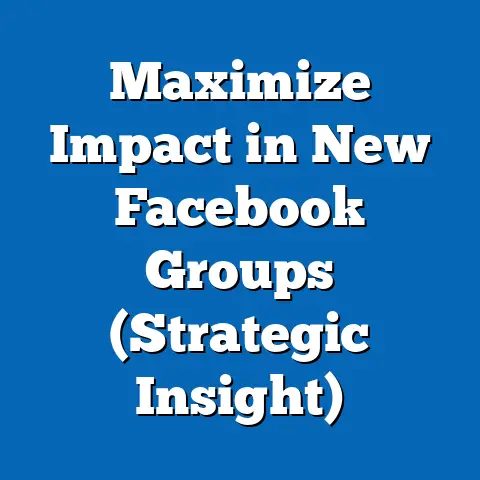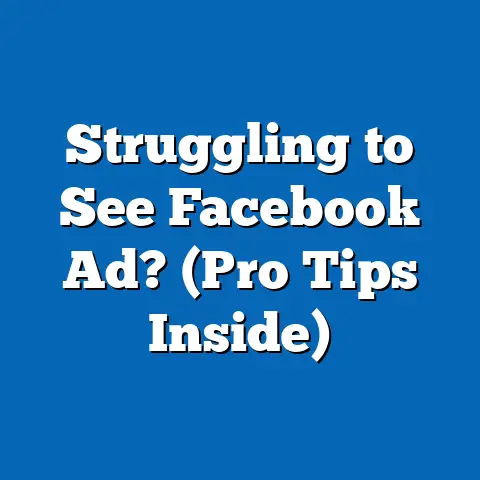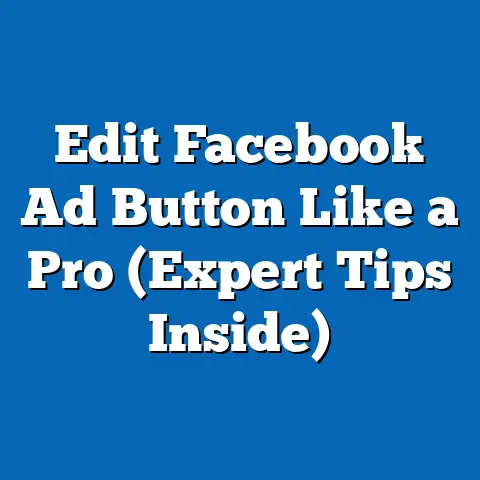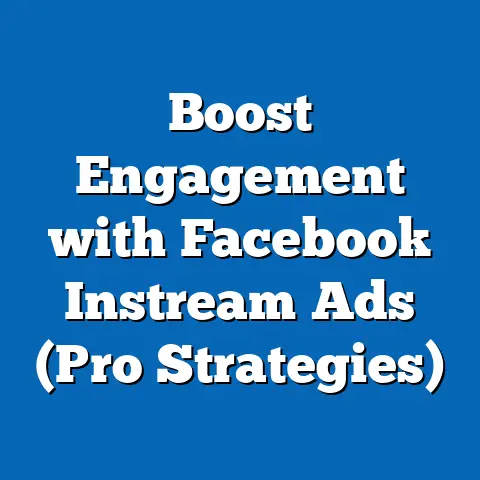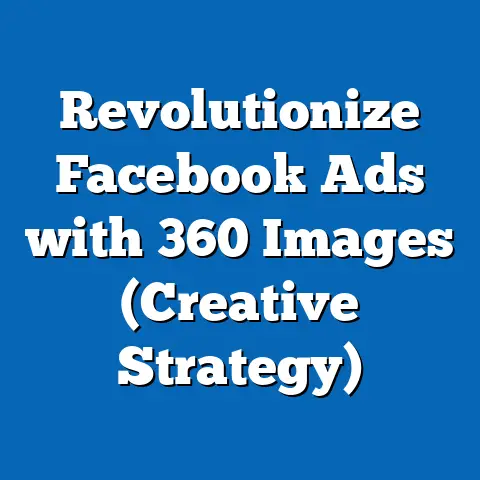Mastering Facebook Ad Auction (Unlocking Optimization Secrets)
Imagine stepping into a smart home where everything is perfectly orchestrated. The lights dim as the sun sets, the thermostat adjusts to your preferred temperature, and your favorite music starts playing as you walk through the door. It’s a seamless integration of technology, all working in harmony to enhance your comfort and convenience. Just like the intricate balance of a smart home system, how do marketers navigate the complex Facebook ad auction to ensure their ads reach the right audience at the right time?
I’ve spent years immersed in the world of Facebook advertising, and I can tell you, it’s a constantly evolving landscape. What worked yesterday might not work today, and what works for one business might not work for another. But one thing remains constant: understanding the Facebook ad auction is crucial for success. Without a solid grasp of how the auction works, you’re essentially throwing money into the digital void.
This guide is designed to be your comprehensive resource for mastering the Facebook ad auction. I’ll break down the complexities, share practical tips, and provide actionable strategies that you can implement to optimize your campaigns and unlock your advertising potential. Get ready to dive deep, because we’re about to unravel the secrets to winning the Facebook ad auction!
Understanding the Facebook Ad Auction
The Facebook ad auction is the engine that drives ad delivery on the platform. It’s a real-time process where Facebook determines which ads to show to which users, based on a variety of factors. Think of it as a high-stakes bidding war where advertisers compete for the attention of their target audience.
Why is it important? Because it directly impacts your ad costs, reach, and overall campaign performance. Understanding the auction allows you to make informed decisions about your bidding strategy, ad quality, and targeting, ultimately leading to better results and a higher return on investment.
How the Auction Works
The Facebook ad auction isn’t just about who bids the most. It’s a complex equation that considers several key components:
- Advertisers: These are the businesses and individuals who create and run ads on Facebook.
- Bids: The amount of money advertisers are willing to pay to show their ad to a specific user.
- Facebook’s Algorithm: The sophisticated system that analyzes all the factors involved and determines the winning ads.
Here’s a simplified breakdown of the process:
- User Action Triggers Auction: Whenever a Facebook user takes an action that could trigger an ad (e.g., opening the app, scrolling through their feed), an auction begins.
- Advertisers Compete: Advertisers targeting that user enter the auction.
- Facebook Evaluates Ads: Facebook’s algorithm evaluates each ad based on bid amount, ad quality, and estimated action rates.
- Winning Ad Selected: The ad with the highest “total value” wins the auction and is shown to the user.
Key Components Influencing Ad Delivery
The “total value” I mentioned earlier is a critical concept. It’s not just about the highest bid. Facebook wants to deliver a positive user experience, so ad quality and relevance play a significant role. Let’s break down these components:
- Bid Amount: How much you’re willing to pay for a specific outcome (e.g., a click, an impression, a conversion).
- Ad Quality: The relevance and engagement of your ad, as perceived by Facebook and its users.
- Estimated Action Rates: Facebook’s prediction of how likely a user is to take a desired action (e.g., clicking on your ad, making a purchase).
Takeaway: The Facebook ad auction is a dynamic process that rewards advertisers who create high-quality, relevant ads and target the right audience. It’s not just about having the deepest pockets.
The Importance of Ad Quality
Ad quality is a cornerstone of success in the Facebook ad auction. Facebook prioritizes ads that are relevant, engaging, and provide a positive user experience. This means that even if you have a high bid, a low-quality ad is unlikely to win the auction.
Why is ad quality so important? Because Facebook wants to keep its users happy and engaged. If users are constantly bombarded with irrelevant or annoying ads, they’re less likely to use the platform. By prioritizing ad quality, Facebook ensures a better overall user experience, which benefits everyone involved.
Defining Ad Quality on Facebook
Ad quality on Facebook encompasses several factors:
- Relevance: How well your ad matches the interests and needs of your target audience.
- Engagement: How users interact with your ad (e.g., likes, comments, shares, clicks).
- Overall User Experience: The overall impact of your ad on the user’s experience on Facebook.
Facebook’s Ad Relevance Diagnostics
Facebook provides advertisers with valuable tools to assess their ad quality. These diagnostics help you understand how your ads are performing and identify areas for improvement. The key metrics include:
- Quality Ranking: A comparison of your ad’s perceived quality against other ads targeting the same audience.
- Above Average: Your ad is performing exceptionally well in terms of quality.
- Average: Your ad is performing as expected.
- Below Average: Your ad’s quality needs improvement.
- Engagement Rate Ranking: A comparison of your ad’s expected engagement rate against other ads targeting the same audience.
- Above Average: Your ad is highly engaging.
- Average: Your ad’s engagement is typical.
- Below Average: Your ad needs to be more engaging.
- Conversion Rate Ranking: A comparison of your ad’s expected conversion rate against other ads targeting the same audience.
- Above Average: Your ad is driving conversions effectively.
- Average: Your ad’s conversion rate is typical.
- Below Average: Your ad needs to improve its conversion rate.
- Above Average: Your ad is performing exceptionally well in terms of quality.
- Average: Your ad is performing as expected.
- Below Average: Your ad’s quality needs improvement.
- Above Average: Your ad is highly engaging.
- Average: Your ad’s engagement is typical.
- Below Average: Your ad needs to be more engaging.
- Above Average: Your ad is driving conversions effectively.
- Average: Your ad’s conversion rate is typical.
- Below Average: Your ad needs to improve its conversion rate.
Personal Story: I once ran a campaign for a local restaurant and initially targeted a broad audience with generic ad copy. The ad relevance diagnostics were consistently “Below Average.” After refining my targeting to focus on users interested in specific cuisines and crafting more personalized ad copy, the rankings jumped to “Above Average,” and my conversion rate skyrocketed.
High-Quality Ads vs. Low-Quality Ads
To illustrate the impact of ad quality, let’s look at some examples:
High-Quality Ad:
- Visual: A high-resolution image or video that is visually appealing and relevant to the product or service being advertised.
- Copy: Clear, concise, and compelling ad copy that highlights the benefits of the product or service and includes a strong call to action.
- Targeting: Precise targeting that ensures the ad is shown to users who are likely to be interested in the offer.
- Relevance: The ad is highly relevant to the user’s interests and needs.
- Engagement: The ad generates a high level of engagement (e.g., likes, comments, shares, clicks).
Low-Quality Ad:
- Visual: A blurry or low-resolution image that is not visually appealing.
- Copy: Vague or confusing ad copy that doesn’t clearly explain the offer or benefits.
- Targeting: Broad or inaccurate targeting that results in the ad being shown to irrelevant users.
- Relevance: The ad is not relevant to the user’s interests or needs.
- Engagement: The ad generates little to no engagement.
Takeaway: Focus on creating high-quality ads that are relevant, engaging, and provide a positive user experience. Use Facebook’s ad relevance diagnostics to monitor your ad quality and make improvements as needed. Remember, a higher quality ad, even with a slightly lower bid, can often outperform a low-quality ad with a higher bid.
Bidding Strategies for Success
Your bidding strategy is a critical component of your Facebook ad auction success. It determines how much you’re willing to pay to show your ad to a specific user and can significantly impact your ad costs and overall campaign performance.
Why is a well-defined bidding strategy important? Because it allows you to control your ad spend and optimize your campaigns for specific goals. A poorly chosen bidding strategy can lead to wasted ad spend and poor results.
Exploring Different Bidding Strategies
Facebook offers a variety of bidding strategies, each designed for different goals and campaign objectives. Here are some of the most common:
- Cost Per Click (CPC): You pay each time someone clicks on your ad. This is a good option if your goal is to drive traffic to your website or landing page.
- Cost Per Impression (CPM): You pay for every 1,000 times your ad is shown. This is a good option if your goal is to increase brand awareness.
- Cost Per Acquisition (CPA): You pay only when someone takes a specific action, such as making a purchase or filling out a form. This is a good option if your goal is to drive conversions.
- Target Cost: You set a target cost for each result you want to achieve, and Facebook will try to deliver results at or below that cost.
- Lowest Cost: Facebook will try to get you the most results possible for your budget.
- Value-Based Bidding: (For e-commerce) You optimize for the value of the purchase, not just the purchase itself.
When to Use Each Strategy:
- CPC: Use when driving traffic to your website or landing page is the primary goal.
- CPM: Use when increasing brand awareness and reaching a large audience is the primary goal.
- CPA: Use when driving conversions and maximizing your return on ad spend is the primary goal.
- Target Cost: Use when you have a specific cost per result in mind and want to control your ad spend.
- Lowest Cost: Use when you want to maximize the number of results you get for your budget.
- Value-Based Bidding: Use when you have an e-commerce store and want to optimize for the value of the purchases made.
Automated Bidding vs. Manual Bidding
Facebook offers both automated and manual bidding options. Automated bidding allows Facebook’s algorithm to automatically adjust your bids based on real-time auction dynamics. Manual bidding gives you more control over your bids but requires more monitoring and adjustment.
- Automated Bidding: Facebook’s algorithm automatically sets bids to achieve your desired results within your budget. It’s a good option for beginners or for campaigns where you want to let Facebook optimize your bids.
- Manual Bidding: You set your bids manually, giving you more control over your ad spend. This is a good option for experienced advertisers who want to fine-tune their campaigns and optimize for specific goals.
When to Use Each:
- Automated Bidding: Best for beginners, campaigns with limited data, or when you want to focus on other aspects of your campaign.
- Manual Bidding: Best for experienced advertisers, campaigns with ample data, or when you want precise control over your bids.
Personal Story: I once managed a campaign for a new product launch and started with automated bidding. After gathering enough data, I switched to manual bidding and was able to significantly reduce my cost per acquisition by carefully adjusting my bids based on real-time performance.
Case Studies of Successful Bidding Strategies
Let’s look at some examples of how different bidding strategies can lead to success:
- Case Study 1: E-commerce Store Using Value-Based Bidding: An e-commerce store selling high-end products used value-based bidding to optimize for the value of the purchases made. This resulted in a significant increase in return on ad spend, as Facebook prioritized users who were likely to make high-value purchases.
- Case Study 2: Local Business Using Target Cost Bidding: A local business used target cost bidding to achieve a specific cost per lead. By setting a target cost, they were able to control their ad spend and ensure that they were getting a good return on their investment.
- Case Study 3: Brand Awareness Campaign Using CPM Bidding: A brand used CPM bidding to increase brand awareness and reach a large audience. By paying for every 1,000 impressions, they were able to expose their brand to a wide range of potential customers.
Takeaway: Choosing the right bidding strategy is crucial for success in the Facebook ad auction. Consider your goals, budget, and experience level when selecting a bidding strategy. Experiment with different strategies and monitor your results to find what works best for your business. Don’t be afraid to switch strategies as your campaign evolves and you gather more data.
Targeting the Right Audience
Targeting is the foundation of any successful Facebook ad campaign. If you’re not showing your ads to the right people, you’re wasting your time and money. Facebook offers a wide range of targeting options, allowing you to reach specific audiences based on their demographics, interests, behaviors, and more.
Why is precise targeting so important? Because it ensures that your ads are shown to users who are most likely to be interested in your offer. This leads to higher engagement, lower ad costs, and a better return on investment.
Understanding Facebook’s Audience Targeting Options
Facebook’s audience targeting options can be broken down into several categories:
- Demographics: Target users based on age, gender, location, education, relationship status, and more.
- Interests: Target users based on their interests, hobbies, and passions. This data is gathered from the pages they like, the groups they join, and the topics they discuss on Facebook.
- Behaviors: Target users based on their online and offline behaviors, such as purchase history, device usage, and travel habits.
- Custom Audiences: Target users based on your own data, such as email lists, website visitors, and app users.
- Lookalike Audiences: Target users who are similar to your existing customers or website visitors. This is a great way to expand your reach and find new potential customers.
- Saved Audiences: Combine demographics, interests, and behaviors to create a highly targeted audience.
Personal Story: I once worked with a client who was selling organic baby food. Initially, they were targeting a broad audience of parents. After analyzing their customer data, I created a custom audience of their existing customers and then used that audience to create a lookalike audience. The lookalike audience performed significantly better than the broad audience, resulting in a much lower cost per acquisition.
The Importance of Audience Segmentation
Audience segmentation is the process of dividing your target audience into smaller, more specific groups based on shared characteristics. This allows you to create more relevant and personalized ads for each segment, leading to higher engagement and better results.
Why is audience segmentation so important? Because it allows you to tailor your ads to the specific needs and interests of each segment. This makes your ads more relevant and engaging, increasing the likelihood that users will take the desired action.
Examples of Audience Segmentation:
- Demographic Segmentation: Segmenting your audience based on age, gender, location, or other demographic factors.
- Interest Segmentation: Segmenting your audience based on their interests and hobbies.
- Behavioral Segmentation: Segmenting your audience based on their online and offline behaviors.
- Purchase History Segmentation: Segmenting your audience based on their past purchases.
- Website Activity Segmentation: Segmenting your audience based on their activity on your website.
Utilizing Facebook’s Audience Insights Tool
Facebook’s Audience Insights tool is a powerful resource for understanding your target audience. It provides valuable data about their demographics, interests, behaviors, and more. This data can help you refine your targeting and create more relevant ads.
How to Use Audience Insights:
- Access Audience Insights: Go to Facebook Ads Manager and select “Audience Insights” from the menu.
- Choose Your Audience: Select whether you want to analyze everyone on Facebook or people who are connected to your page.
- Explore Demographics: View data about the age, gender, location, relationship status, education level, and job titles of your audience.
- Explore Interests: View data about the pages your audience likes, the topics they discuss, and the activities they engage in.
- Explore Behaviors: View data about your audience’s online and offline behaviors, such as purchase history, device usage, and travel habits.
- Refine Your Targeting: Use the data you gather from Audience Insights to refine your targeting in your ad campaigns.
Takeaway: Targeting the right audience is crucial for success in the Facebook ad auction. Take the time to understand your target audience and use Facebook’s targeting options to reach them effectively. Utilize Audience Insights to gather valuable data about your audience and refine your targeting. Don’t be afraid to experiment with different targeting options and audience segments to find what works best for your business.
Crafting Compelling Ad Content
Even with the perfect bidding strategy and laser-focused targeting, your campaign will fall flat if your ad content doesn’t resonate with your audience. Compelling ad content is what grabs attention, sparks interest, and ultimately drives conversions.
Why is compelling ad content so important? Because it’s the first thing users see when they encounter your ad. If your ad doesn’t capture their attention and communicate your message effectively, they’re likely to scroll right past it.
Elements of a Successful Ad
A successful Facebook ad typically includes the following elements:
- Attention-Grabbing Visuals: High-quality images or videos that are visually appealing and relevant to your offer.
- Persuasive Copy: Clear, concise, and compelling ad copy that highlights the benefits of your product or service and includes a strong call to action.
- Strong Call to Action: A clear and concise instruction that tells users what you want them to do (e.g., “Shop Now,” “Learn More,” “Sign Up”).
- Relevance: The ad is highly relevant to the user’s interests and needs.
- Value Proposition: Clearly communicates the value of your product or service to the user.
- Social Proof: Incorporates elements of social proof, such as testimonials, reviews, or endorsements.
A/B Testing Different Ad Formats and Content
A/B testing, also known as split testing, is the process of comparing two versions of your ad to see which one performs better. This is a crucial step in optimizing your ad content and ensuring that you’re using the most effective visuals and copy.
How to A/B Test:
- Create Two Versions of Your Ad: Create two versions of your ad with slight variations in the visuals, copy, or call to action.
- Run the Ads Simultaneously: Run both ads simultaneously to the same target audience.
- Track the Results: Track the performance of each ad, paying attention to metrics such as click-through rate, conversion rate, and cost per acquisition.
- Analyze the Results: Analyze the results to see which ad performed better.
- Implement the Winning Ad: Implement the winning ad in your campaign and continue to test different variations to optimize your content.
Personal Story: I once ran an A/B test for a client who was selling online courses. I tested two different headlines: “Learn a New Skill Today” and “Transform Your Career with Our Online Courses.” The second headline, which focused on the long-term benefits of the course, performed significantly better, resulting in a higher click-through rate and conversion rate.
Examples of Compelling Ad Copy and Visuals
Let’s look at some examples of compelling ad copy and visuals that have led to increased engagement and conversions:
- Example 1: E-commerce Store Using High-Quality Product Images: An e-commerce store used high-quality product images that showcased the details and features of their products. This resulted in a significant increase in click-through rate and sales.
- Example 2: Software Company Using Video Testimonials: A software company used video testimonials from satisfied customers to build trust and credibility. This resulted in a higher conversion rate and more sign-ups.
- Example 3: Local Business Using Location-Based Targeting and Personalized Ad Copy: A local business used location-based targeting and personalized ad copy to reach customers in their area. This resulted in a higher click-through rate and more foot traffic to their store.
Takeaway: Crafting compelling ad content is essential for success in the Facebook ad auction. Use high-quality visuals, persuasive copy, and strong calls to action to capture attention and drive conversions. A/B test different ad formats and content to see what resonates best with your target audience. Continuously monitor your ad performance and make adjustments as needed to optimize your content.
Analyzing and Adjusting Campaign Performance
The Facebook ad auction is a dynamic environment, and your campaign performance can fluctuate over time. It’s crucial to continuously analyze your campaign performance and make adjustments as needed to optimize your results.
Why is ongoing analysis so important? Because it allows you to identify what’s working and what’s not, and make informed decisions about how to improve your campaign performance. Without ongoing analysis, you’re essentially flying blind and wasting your ad spend.
Key Performance Indicators (KPIs) to Track
There are several key performance indicators (KPIs) that you should track to monitor your campaign performance:
- Click-Through Rate (CTR): The percentage of users who click on your ad after seeing it. A high CTR indicates that your ad is relevant and engaging.
- Conversion Rate: The percentage of users who take a desired action (e.g., make a purchase, fill out a form) after clicking on your ad. A high conversion rate indicates that your landing page is effective and that your offer is compelling.
- Cost Per Click (CPC): The amount you pay each time someone clicks on your ad. A low CPC indicates that your ad is performing efficiently.
- Cost Per Acquisition (CPA): The amount you pay for each desired action (e.g., a purchase, a lead). A low CPA indicates that your campaign is generating a good return on investment.
- Return on Ad Spend (ROAS): The amount of revenue you generate for every dollar you spend on advertising. A high ROAS indicates that your campaign is profitable.
- Ad Relevance Diagnostics: The metrics I mentioned earlier: Quality Ranking, Engagement Rate Ranking, and Conversion Rate Ranking.
Using Facebook Ads Manager and Other Analytics Tools
Facebook Ads Manager provides a wealth of data about your campaign performance. You can use it to track your KPIs, analyze your results, and make adjustments to your campaign.
How to Use Facebook Ads Manager:
- Access Facebook Ads Manager: Go to Facebook Ads Manager and select your campaign.
- View Your Performance: View your campaign performance data, including impressions, clicks, conversions, and cost per result.
- Customize Your Columns: Customize your columns to show the KPIs that are most important to you.
- Filter Your Data: Filter your data by date range, ad set, or ad to analyze your results in more detail.
- Export Your Data: Export your data to a spreadsheet for further analysis.
In addition to Facebook Ads Manager, there are several other analytics tools that you can use to monitor your campaign performance, such as Google Analytics and third-party tracking platforms.
Making Data-Driven Adjustments
Based on your analysis, you can make several adjustments to your campaign to improve performance:
- Adjust Your Bidding Strategy: Change your bidding strategy to optimize for different goals, such as traffic, conversions, or brand awareness.
- Refine Your Targeting: Refine your targeting to reach a more specific audience.
- Update Your Ad Content: Update your ad content to make it more relevant and engaging.
- Optimize Your Landing Page: Optimize your landing page to improve your conversion rate.
- Pause Underperforming Ads: Pause ads that are not performing well to save money and focus on your top performers.
- Reallocate Your Budget: Reallocate your budget to ad sets that are performing well.
Personal Story: I once managed a campaign for a lead generation client and noticed that one of my ad sets was performing significantly better than the others. I reallocated my budget to that ad set and was able to increase my overall lead volume by 30%.
Takeaway: Analyzing and adjusting your campaign performance is a continuous process. Track your KPIs, use Facebook Ads Manager and other analytics tools to monitor your results, and make data-driven adjustments to optimize your campaign. Don’t be afraid to experiment with different options and strategies to find what works best for your business.
Advanced Optimization Techniques
Once you’ve mastered the basics of the Facebook ad auction, you can start exploring advanced optimization techniques to take your campaigns to the next level. These techniques can help you reach a wider audience, drive more conversions, and maximize your return on investment.
Why are advanced optimization techniques important? Because they allow you to leverage the full power of the Facebook ad platform and stay ahead of the competition. In a constantly evolving landscape, it’s crucial to continuously learn and adapt your strategies.
Retargeting Strategies
Retargeting is the process of showing ads to users who have previously interacted with your business, such as visiting your website, viewing your products, or adding items to their cart. This is a highly effective strategy for driving conversions, as you’re targeting users who have already shown an interest in your brand.
Types of Retargeting:
- Website Retargeting: Showing ads to users who have visited your website.
- App Retargeting: Showing ads to users who have downloaded your app.
- Customer List Retargeting: Showing ads to users who are on your customer list.
- Engagement Retargeting: Showing ads to users who have engaged with your content on Facebook or Instagram.
Personal Story: I once ran a retargeting campaign for an e-commerce store and saw a significant increase in sales. By showing ads to users who had previously added items to their cart but didn’t complete their purchase, I was able to recover a significant amount of lost revenue.
Lookalike Audiences
Lookalike audiences are a powerful way to expand your reach and find new potential customers. Facebook uses its algorithm to identify users who are similar to your existing customers or website visitors. This allows you to target a wider audience with a higher likelihood of being interested in your offer.
How to Create a Lookalike Audience:
- Go to Facebook Ads Manager: Go to Facebook Ads Manager and select “Audiences” from the menu.
- Create a New Audience: Click on “Create Audience” and select “Lookalike Audience.”
- Choose Your Source: Choose your source audience, such as your customer list, website visitors, or page fans.
- Select Your Audience Size: Select the size of your lookalike audience, ranging from 1% to 10% of the population in your target country. A smaller audience will be more similar to your source audience, while a larger audience will be less similar but will have a wider reach.
- Create Your Audience: Click on “Create Audience” to create your lookalike audience.
Dynamic Ads
Dynamic ads are a type of ad that automatically shows users the products or services they’ve previously viewed on your website or app. This is a highly effective strategy for driving conversions, as you’re showing users exactly what they’re interested in.
How Dynamic Ads Work:
- Upload Your Product Catalog: Upload your product catalog to Facebook.
- Set Up Your Dynamic Ad Template: Set up your dynamic ad template, which will be used to create the ads that are shown to users.
- Target Your Audience: Target users who have previously viewed your products or services on your website or app.
- Facebook Automatically Creates Ads: Facebook automatically creates ads that show users the products or services they’ve viewed.
The Role of Machine Learning and AI
Machine learning and AI are playing an increasingly important role in optimizing ad delivery and performance. Facebook’s algorithm uses machine learning to analyze vast amounts of data and make predictions about which ads are most likely to be successful. This allows you to automate many of the tasks that were previously done manually, such as bidding, targeting, and ad content optimization.
Examples of Machine Learning in Facebook Ads:
- Automated Bidding: Facebook’s algorithm automatically adjusts your bids based on real-time auction dynamics.
- Lookalike Audiences: Facebook’s algorithm identifies users who are similar to your existing customers or website visitors.
- Dynamic Ads: Facebook’s algorithm automatically shows users the products or services they’ve previously viewed on your website or app.
- Ad Relevance Diagnostics: Facebook’s algorithm assesses the relevance and quality of your ads.
Leveraging Seasonal Trends and Events
Leveraging seasonal trends and events is a great way to optimize your ad campaigns for specific times of the year. By tailoring your ads to specific holidays, events, or seasons, you can increase their relevance and engagement.
Examples of Seasonal Trends and Events:
- Holidays: Christmas, Thanksgiving, Easter, etc.
- Events: Black Friday, Cyber Monday, Back to School, etc.
- Seasons: Summer, Winter, Spring, Autumn.
Takeaway: Advanced optimization techniques can help you take your Facebook ad campaigns to the next level. Explore retargeting strategies, lookalike audiences, and dynamic ads to reach a wider audience, drive more conversions, and maximize your return on investment. Leverage machine learning and AI to automate tasks and optimize your campaigns. Tailor your ads to seasonal trends and events to increase their relevance and engagement.
Common Pitfalls and How to Avoid Them
Even with the best strategies and techniques, it’s easy to make mistakes in the Facebook ad auction process. Understanding common pitfalls and how to avoid them can help you save money, improve your campaign performance, and achieve your advertising goals.
Why is it important to avoid common pitfalls? Because mistakes can lead to wasted ad spend, poor results, and frustration. By learning from the experiences of others, you can avoid these pitfalls and optimize your campaigns for success.
Poor Targeting
One of the most common mistakes is targeting the wrong audience. This can lead to low engagement, high ad costs, and poor results.
How to Avoid Poor Targeting:
- Understand Your Target Audience: Take the time to understand your target audience and their interests, behaviors, and demographics.
- Use Facebook’s Targeting Options: Utilize Facebook’s targeting options to reach a specific audience.
- Test Different Targeting Options: Experiment with different targeting options and audience segments to find what works best for your business.
- Use Lookalike Audiences: Use lookalike audiences to expand your reach and find new potential customers.
- Refine Your Targeting: Continuously refine your targeting based on your campaign performance data.
Inadequate Budgeting
Another common mistake is not allocating enough budget to your campaigns. This can lead to limited reach, low engagement, and poor results.
How to Avoid Inadequate Budgeting:
- Determine Your Advertising Goals: Determine your advertising goals and the amount you’re willing to spend to achieve them.
- Set a Realistic Budget: Set a realistic budget based on your advertising goals and your target audience.
- Monitor Your Campaign Performance: Monitor your campaign performance and adjust your budget as needed.
- Use Automated Bidding: Use automated bidding to optimize your budget and get the most results possible.
- Reallocate Your Budget: Reallocate your budget to ad sets that are performing well.
Neglecting Ad Quality
As I’ve emphasized throughout this guide, neglecting ad quality is a major pitfall. Low-quality ads are unlikely to win the auction, even with a high bid.
How to Avoid Neglecting Ad Quality:
- Use High-Quality Visuals: Use high-quality images or videos that are visually appealing and relevant to your offer.
- Write Persuasive Copy: Write clear, concise, and compelling ad copy that highlights the benefits of your product or service and includes a strong call to action.
- A/B Test Your Ads: A/B test different ad formats and content to see what resonates best with your target audience.
- Ensure Relevance: Ensure that your ads are relevant to the user’s interests and needs.
- Monitor Ad Relevance Diagnostics: Monitor your ad relevance diagnostics and make improvements as needed.
Ignoring Mobile Optimization
In today’s mobile-first world, ignoring mobile optimization is a critical mistake. Most Facebook users access the platform on their mobile devices, so your ads need to be optimized for mobile viewing.
How to Avoid Ignoring Mobile Optimization:
- Use Mobile-Friendly Ad Formats: Use mobile-friendly ad formats, such as video ads and carousel ads.
- Optimize Your Landing Page for Mobile: Optimize your landing page for mobile viewing, ensuring that it loads quickly and is easy to navigate on a mobile device.
- Use Mobile-Specific Targeting: Use mobile-specific targeting options to reach users on their mobile devices.
- Test Your Ads on Mobile: Test your ads on mobile devices to ensure that they look good and function properly.
Lack of A/B Testing
Failing to A/B test your ads is a missed opportunity to optimize your campaign performance. A/B testing allows you to compare different versions of your ad and see which one performs better.
How to Avoid Lack of A/B Testing:
- Create a Testing Plan: Create a testing plan that outlines what you want to test and how you will measure the results.
- Test One Variable at a Time: Test one variable at a time to isolate the impact of each variable.
- Track Your Results: Track your results and analyze the data to see which ad performed better.
- Implement the Winning Ad: Implement the winning ad in your campaign and continue to test different variations.
Inconsistent Monitoring
Failing to monitor your campaign performance regularly is a recipe for disaster. The Facebook ad auction is a dynamic environment, and your campaign performance can fluctuate over time.
How to Avoid Inconsistent Monitoring:
- Set Up a Monitoring Schedule: Set up a monitoring schedule and check your campaign performance regularly.
- Track Your KPIs: Track your key performance indicators (KPIs) to monitor your campaign performance.
- Use Facebook Ads Manager: Use Facebook Ads Manager to view your campaign performance data.
- Set Up Alerts: Set up alerts to notify you of any significant changes in your campaign performance.
Takeaway: Avoiding common pitfalls is crucial for success in the Facebook ad auction. Understand your target audience, allocate an adequate budget, create high-quality ads, optimize for mobile, A/B test your ads, and monitor your campaign performance regularly. By learning from the experiences of others, you can avoid these pitfalls and optimize your campaigns for success.
Conclusion
Just like the intricate balance and automation of a smart home, mastering the Facebook ad auction requires a strategic approach, continuous optimization, and a willingness to adapt to the ever-changing digital landscape. Throughout this guide, I’ve shared insights, practical tips, and actionable strategies to help you navigate the complexities of the auction and unlock your advertising potential.
Remember, mastering the Facebook ad auction is not a one-time achievement, but a continuous journey. It requires experimentation, analysis, and adaptation to succeed in a competitive marketplace. The strategies and techniques I’ve shared are a starting point, and it’s up to you to tailor them to your specific business and advertising goals.
Embrace the optimization secrets unveiled in this article and implement them in your advertising strategies. Continuously test, analyze, and refine your campaigns to maximize your return on investment and achieve your advertising goals. The Facebook ad auction is a dynamic environment, and those who are willing to learn and adapt will ultimately succeed.
Now, go forth and conquer the Facebook ad auction! I’m confident that with the knowledge and strategies you’ve gained from this guide, you’ll be well-equipped to achieve your advertising goals and drive your business to new heights. Good luck!

